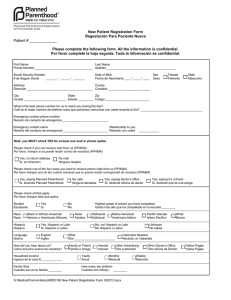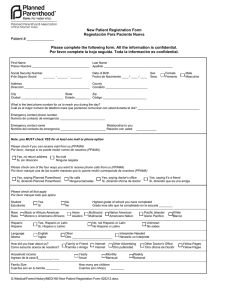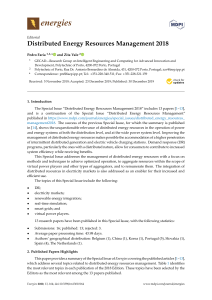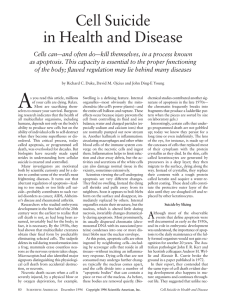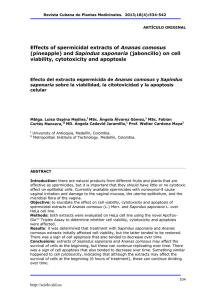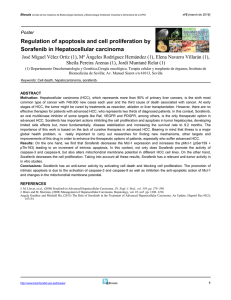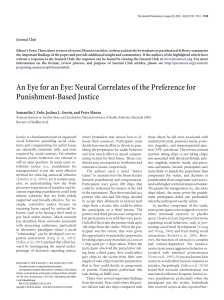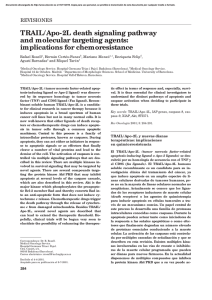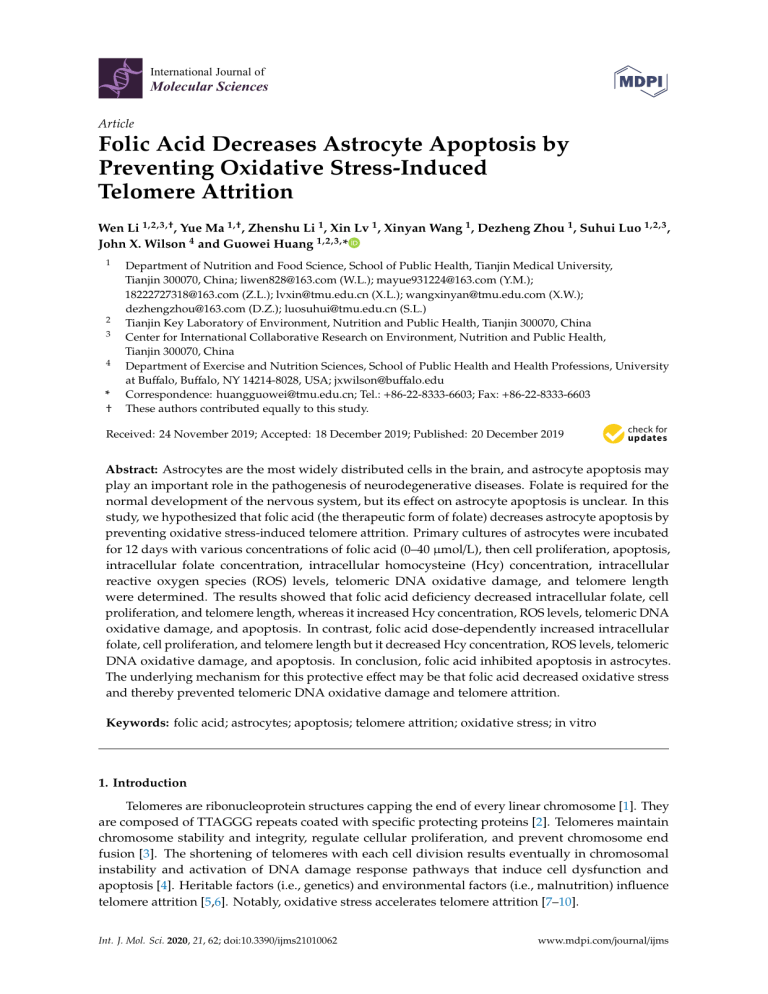
International Journal of Molecular Sciences Article Folic Acid Decreases Astrocyte Apoptosis by Preventing Oxidative Stress-Induced Telomere Attrition Wen Li 1,2,3,† , Yue Ma 1,† , Zhenshu Li 1 , Xin Lv 1 , Xinyan Wang 1 , Dezheng Zhou 1 , Suhui Luo 1,2,3 , John X. Wilson 4 and Guowei Huang 1,2,3, * 1 2 3 4 * † Department of Nutrition and Food Science, School of Public Health, Tianjin Medical University, Tianjin 300070, China; [email protected] (W.L.); [email protected] (Y.M.); [email protected] (Z.L.); [email protected] (X.L.); [email protected] (X.W.); [email protected] (D.Z.); [email protected] (S.L.) Tianjin Key Laboratory of Environment, Nutrition and Public Health, Tianjin 300070, China Center for International Collaborative Research on Environment, Nutrition and Public Health, Tianjin 300070, China Department of Exercise and Nutrition Sciences, School of Public Health and Health Professions, University at Buffalo, Buffalo, NY 14214-8028, USA; [email protected] Correspondence: [email protected]; Tel.: +86-22-8333-6603; Fax: +86-22-8333-6603 These authors contributed equally to this study. Received: 24 November 2019; Accepted: 18 December 2019; Published: 20 December 2019 Abstract: Astrocytes are the most widely distributed cells in the brain, and astrocyte apoptosis may play an important role in the pathogenesis of neurodegenerative diseases. Folate is required for the normal development of the nervous system, but its effect on astrocyte apoptosis is unclear. In this study, we hypothesized that folic acid (the therapeutic form of folate) decreases astrocyte apoptosis by preventing oxidative stress-induced telomere attrition. Primary cultures of astrocytes were incubated for 12 days with various concentrations of folic acid (0–40 µmol/L), then cell proliferation, apoptosis, intracellular folate concentration, intracellular homocysteine (Hcy) concentration, intracellular reactive oxygen species (ROS) levels, telomeric DNA oxidative damage, and telomere length were determined. The results showed that folic acid deficiency decreased intracellular folate, cell proliferation, and telomere length, whereas it increased Hcy concentration, ROS levels, telomeric DNA oxidative damage, and apoptosis. In contrast, folic acid dose-dependently increased intracellular folate, cell proliferation, and telomere length but it decreased Hcy concentration, ROS levels, telomeric DNA oxidative damage, and apoptosis. In conclusion, folic acid inhibited apoptosis in astrocytes. The underlying mechanism for this protective effect may be that folic acid decreased oxidative stress and thereby prevented telomeric DNA oxidative damage and telomere attrition. Keywords: folic acid; astrocytes; apoptosis; telomere attrition; oxidative stress; in vitro 1. Introduction Telomeres are ribonucleoprotein structures capping the end of every linear chromosome [1]. They are composed of TTAGGG repeats coated with specific protecting proteins [2]. Telomeres maintain chromosome stability and integrity, regulate cellular proliferation, and prevent chromosome end fusion [3]. The shortening of telomeres with each cell division results eventually in chromosomal instability and activation of DNA damage response pathways that induce cell dysfunction and apoptosis [4]. Heritable factors (i.e., genetics) and environmental factors (i.e., malnutrition) influence telomere attrition [5,6]. Notably, oxidative stress accelerates telomere attrition [7–10]. Int. J. Mol. Sci. 2020, 21, 62; doi:10.3390/ijms21010062 www.mdpi.com/journal/ijms Int. J. Mol. Sci. 2020, 21, 62 2 of 12 Folate (vitamin B9) acts as a coenzyme to transfer one-carbon units that are necessary for deoxythymidylate synthesis, purine synthesis, and various methylation reactions. For example, folate is an important co-factor in the re-methylation process of homocysteine (Hcy) metabolism [11]. Consequently, folate deficiency leads to Hcy accumulation. Excessive Hcy, in turn, may cause oxidative stress in neurodegenerative disorders [12–14]. For instance, high circulating levels of Hcy (i.e., hyperhomocysteinemia) is a risk factor for Alzheimer’s disease [15,16]. Folic acid is the form of folate that is used therapeutically. It stimulates the proliferation of neural stem Int. cells and the differentiation of neurons in vitro and in vivo [17,18]. Folic acid also supports the J. Mol. Sci. 2019, 20, x FOR PEER REVIEW 2 of 12 survival and proliferation of Schwann cells and PC-12 cells and it induces the migration of Schwann cells and astrocytes [18]. Folate is oxidative associated with the survival of disorders astrocytes in the accumulation. Excessive Hcy, in metabolism turn, may cause stress in neurodegenerative [12–14]. Forbrain, instance, high circulating levels of Hcy (i.e., hyperhomocysteinemia) is a risk factor for Alzheimer’s disease as evidenced by the observation that methotrexate induces astrocyte apoptosis by disrupting folate [15,16]. [19]. However, whether folic acid can protect against astrocyte apoptosis is unclear. metabolism Folic acid is the form of folate that is used therapeutically. It stimulates the proliferation of neural stem cells This knowledge gap is important because astrocytes are the most widely distributed cells in the brain and the differentiation of neurons in vitro and in vivo [17,18]. Folic acid also supports the survival and and astrocyte apoptosis may contribute to the pathogenesis of neurodegenerative disorders such as proliferation of Schwann cells and PC-12 cells and it induces the migration of Schwann cells and astrocytes [18]. Alzheimer’s disease Thewith present studyoftested the in hypothesis folic acid Folate metabolism[20,21]. is associated the survival astrocytes the brain, asthat evidenced by thedecreases observationoxidative that stress-induced astrocyte apoptosis by preventing attrition. methotrexate induces astrocyte apoptosis by disruptingtelomere folate metabolism [19]. However, whether folic acid can protect against astrocyte apoptosis is unclear. This knowledge gap is important because astrocytes are the most 2. Results widely distributed cells in the brain and astrocyte apoptosis may contribute to the pathogenesis of neurodegenerative disorders such as Alzheimer’s disease [20,21]. The present study tested the hypothesis that 2.1. Folic Increased Cell Proliferation and Decreased Apoptosis folic Acid acid decreases oxidative stress-induced astrocyte apoptosis by preventing telomere attrition. Incubation for 12 days with various concentration of folic acid (0–40 µmol/L) had multiple effects 2. Results on astrocytes. Folic acid deficiency decreased cell proliferation compared with high-dose folic acid 2.1. Folic(20 Acid Cell Proliferation Apoptosis treatments orIncreased 40 µmol/L) (Figure and 1a).Decreased Folic acid increased cell proliferation in a dose-dependent manner (rIncubation = 0.756, for p =120.004). Cell proliferation rate theacid high-dose folichad acid groupeffects (40 µmol/L) days with various concentration ofin folic (0–40 μmol/L) multiple on was 1.1 times that the normaldecreased folic acid (10 µmol/L, p< 0.05, Figurefolic 1b).acid Cell apoptosis astrocytes. Folic in acid deficiency cellgroup proliferation compared with high-dose treatments (20 was or 40 μmol/L) (Figure 1a). Folic and acid increased cell proliferation a dose-dependent mannerFlow (r = 0.756, p = 0.004). data measured by flow cytometry fluorescence staininginwith Hoechst 33342. cytometry Cell proliferation rate dose-dependently in the high-dose folic acid group (40astrocyte μmol/L) was 1.1 times (r that the normal acidsince revealed that folic acid decreased apoptosis = in −0.799, p = folic 0.002), group (10 μmol/L, p < 0.05, Figure 1b). Cell apoptosis was measured by flow cytometry and fluorescence staining the total percent apoptosis rates in the presence of folic acid at 0, 10, 20, or 40 µmol/L were, respectively, with Hoechst 33342. Flow cytometry data revealed that folic acid dose-dependently decreased astrocyte 14.33 ± 4.2, 6.42 ± 3.00, 5.15 ± 2.79, 3.78 ± 3.10 (Figure 2a,c). Hoechst 33342 staining revealed a similar apoptosis (r = −0.799, p = 0.002), since the total percent apoptosis rates in the presence of folic acid at 0, 10, 20, or trend40 (r μmol/L = −0.928, p = 0.000), since the total percent apoptosis rates in the presence of folic acid at 0, 10, were, respectively, 14.33 ± 4.2, 6.42 ± 3.00, 5.15 ± 2.79, 3.78 ± 3.10 (Figure 2a and c). Hoechst 33342 20 or staining 40 µmol/L were, respectively, ±p2.03, 7.64since ± 0.53, 6.57percent ± 0.76, 5.06 ±0.91 2b,d). ofTaken revealed a similar trend (r =16.73 −0.928, = 0.000), the total apoptosis rates(Figure in the presence together, that folic acid decreased apoptosis and increased proliferation in folic these acid at results 0, 10, 20 indicated or 40 μmol/L were, respectively, 16.73 ± 2.03, 7.64 ± 0.53, 6.57 ± 0.76, 5.06cell ±0.91 (Figure 2b and d). Taken together, these results indicated that folic acid decreased apoptosis and increased cell proliferation a dose-dependent manner. in a dose-dependent manner. Figure 1. acid Folicincreased acid increased cell proliferation in primary astrocytes. Primary cultures rat Figure 1. Folic cell proliferation in primary astrocytes. Primary cultures of rat of astrocytes astrocytes were incubated for 12 days with various concentrations of folic acid (0–40 μmol/L). (a) Cell were incubated for 12 days with various concentrations of folic acid (0–40 µmol/L). (a) Cell morphology morphology by light microscopy. 100 μm. (b)of Barcell graph of cell proliferation rates observed by lightobserved microscopy. Scale bar = 100Scale µm.bar (b)= Bar graph proliferation rates determined determined by ® the CellTiter 96® AQueous One Solution Cell Proliferation Assay. The plotted values by the CellTiter 96 AQueous One Solution Cell Proliferation Assay. The plotted values represent represent the mean ± SEM values of three experiments. * p < 0.05 compared with the folic acid-deficient the mean ± SEM values of three experiments. * p < 0.05 compared with the folic acid-deficient group group (0 μmol/L), # p < 0.05 compared with the normal-folic acid group (10 μmol/L). (0 µmol/L), # p < 0.05 compared with the normal-folic acid group (10 µmol/L). Int. J. Mol. Sci. 2020, 21, 62 Int. J. Mol. Sci. 2019, 20, x FOR PEER REVIEW 3 of 12 3 of 12 Figure 2. Folic acid decreased apoptosis in primary astrocytes. Primary astrocytes were incubated Figure 2. Folic acid decreased in primary astrocytes. incubated as described in Figure 1. (a)apoptosis Scatter plots of apoptosis detectedPrimary by flowastrocytes cytometry were (staining with as described in Figureand 1. (a) Scatter iodide plots of apoptosis detected by the flow cytometry (staining AnnexinV–FITC propidium (PI)). Live cells appear in bottom left square, early with AnnexinV–FITC propidium iodide (PI)). Liveand cells in cells the appear bottominleft apoptotic cellsand appear in the bottom right square, lateappear apoptotic the square, top rightearly square.cells (b) Fluorescence staining of apoptotic cells by Hoechst 33342 (green) and nuclearinstaining byright apoptotic appear in the bottom right square, and late apoptotic cells appear the top 0 ,6-diamidino-2-phenylindole (DAPI) (blue). Scale bar = 100 µm. (c) Bar graph of total apoptotic 4 square. (b) Fluorescence staining of apoptotic cells by Hoechst 33342 (green) and nuclear staining by rates determined by flow cytometry. (d) BarScale graphbar of total rates determined Hoechstrates 4′,6-diamidino-2-phenylindole (DAPI) (blue). = 100apoptotic μm. (c) Bar graph of totalby apoptotic 33342 fluorescence staining. The plotted values represent the mean ± SEM values of three experiments. determined by flow cytometry. (d) Bar graph of total apoptotic rates determined by Hoechst 33342 * p < 0.05 compared with the folic acid-deficient group (0 µmol/L), # p < 0.05 compared with the fluorescence staining. The plotted values represent the mean ± SEM values of three experiments. * p normal-folic acid group (10 µmol/L). < 0.05 compared with the folic acid-deficient group (0 μmol/L), # p < 0.05 compared with the normal2.2. Decreased Intracellular Hcy and ROS folicFolic acidAcid group (10 μmol/L). After 12 days of intervention, the intracellular folate concentration was very low in the folic 2.2. Folic Acid Decreased Intracellular Hcydose and of ROS acid-deficient group, while a high folic acid (40 µmol/L) increased intracellular folate compared with of folic acid µmol/L) (p folate < 0.05)concentration (Figure 3a). The Afterthe 12normal days ofdose intervention, the(10 intracellular wasintracellular very low inHcy the concentration folic acid-deficient increased in the folic acid-deficient group, but a high dose of folic acid (40 µmol/L) decreased group, while a high dose of folic acid (40 μmol/L) increased intracellular folate compared with the normal dose intracellular Hcy compared with the normal dose (10 µmol/L) (Figure 3b). Similarly, the intracellular of folic acid (10 μmol/L) (p < 0.05) (Figure 3a). The intracellular Hcy concentration increased in the folic acidreactive oxygen species (ROS) level was raised by folic acid deficiency and lowered by a high dose of deficient group, but a high dose of folic acid (40 μmol/L) decreased intracellular Hcy compared with the normal folic acid (40 µmol/L) (Figure 3c). dose (10 μmol/L) (Figure 3b). Similarly, the intracellular reactive oxygen species (ROS) level was raised by folic acid deficiency and lowered by a high dose of folic acid (40 μmol/L) (Figure 3c). Int. J. Mol. Sci. 2020, 21, 62 Int. J. Mol. Sci. 2019, 20, x FOR PEER REVIEW 4 of 12 4 of 12 Figure 3. Folic acid increased intracellular folate concentration and decreased homocysteine (Hcy) Figure 3. Folic acid increased intracellular folate concentration and decreased homocysteine (Hcy) and reactive speciesspecies (ROS)(ROS) levels. Primary were incubated as described andoxygen reactive oxygen levels. Primaryastrocytes astrocytes were incubated as described in Figurein Figure 1. ® 2000 ® Intracellular folate concentration waswas determined withthethe IMMULITE 2000 1. Intracellular folate concentration determined with IMMULITE Folic AcidFolic kit andAcid an kit and ®2000 System analyzer. Hcy concentration was measured with an ELISA kit. Intracellular ® 2000 IMMULITE an IMMULITE System analyzer. Hcy concentration was measured with an ELISA kit. Intracellular levels were determined 0by 02′,7′-dichlorofluorescin diacetate staining and flow cytometry. (a) Bar ROS levelsROS were determined by 2 ,7 -dichlorofluorescin diacetate staining and flow cytometry. (a) Bar graph of intracellular folate concentration. (b) Bar graph of intracellular Hcy concentration. (c) Bar graph of intracellular folate concentration. (b) Bar graph of intracellular Hcy concentration. (c) Bar graph of mean ROS intensity. The plotted values represent the mean ± SEM values of three separate graph of mean ROS intensity. The plotted values represent the mean ± SEM of three separate experiments. * p < 0.05 compared with the folic acid-deficient group (0 μmol/L), # pvalues < 0.05 compared with*the normal-folic acid group (10 the μmol/L). experiments. p< 0.05 compared with folic acid-deficient group (0 µmol/L), # p < 0.05 compared with the normal-folic acid group (10 µmol/L). 2.3. Folic Acid Inhibited Telomeric DNA Oxidative Damage 2.3. Folic Acid The Inhibited Telomeric Oxidative Damage incorporation ratio DNA of 8-oxoG within telomeric DNA was increased by folic acid deficiency and decreased by high folic acid concentrations (20 and 40 μM) in a dose-dependent manner (r = −0.907, p = 0.000) The incorporation ratio of 8-oxoG within telomeric DNA was folic acid (Figure 4). The ratio of telomere dysfunction-induced foci (TIF)-positive cells inincreased the folic acidby deficiency groupdeficiency was 2.83 times that in the normal folic acid group (10 μmol/L, p < 0.05, Figure 5). High concentrations of folic(r = −0.907, and decreased by high folic acid concentrations (20 and 40 µM) in a dose-dependent manner acid decreased the abundance of TIF-positive cells dose-dependently (r = −0.950, p = 0.000) (Figure 5). p = 0.000) (Figure 4). The ratio of telomere dysfunction-induced foci (TIF)-positive cells in the folic acid deficiency group was 2.83 times that in the normal folic acid group (10 µmol/L, p < 0.05, Figure 5). High concentrations of folic acid decreased the abundance of TIF-positive cells dose-dependently (r = −0.950, p = 0.000) (Figure Int. J. Mol. Sci. 2019, 20, 5). x FOR PEER REVIEW 5 of 12 Figure 4. Folic acid treatment 8-oxoG in telomeric DNA. Primary astrocytes Figure 4. Folic acidinhibited treatment inhibited 8-oxoGincorporation incorporation in telomeric DNA. Primary astrocytes incubated as described in Figure RT-qPCR was was used toused detect 8-oxoG in telomeric DNA. The were incubated aswere described in Figure 1. 1.RT-qPCR to detect 8-oxoG in telomeric DNA. plotted values represent the mean ± SEM values of three separate experiments. * p < 0.05 compared The plotted valueswith represent the mean ± SEM values of three separate experiments. * the folic acid-deficient group (0 μmol/L), # p < 0.05 compared with the normal-folic acid groupp < 0.05 compared (10 μmol/L). with the folic acid-deficient group (0 µmol/L), # p < 0.05 compared with the normal-folic acid group (10 µmol/L). were incubated as described in Figure 1. RT-qPCR was used to detect 8-oxoG in telomeric DNA. The plotted values represent the mean ± SEM values of three separate experiments. * p < 0.05 compared with the folic acid-deficient group (0 μmol/L), # p < 0.05 compared with the normal-folic acid group (10 μmol/L). Int. J. Mol. Sci. 2020, 21, 62 5 of 12 Figure 5. Folic acid decreased the abundance of telomere dysfunction-induced foci (TIF)-positive cells. Figure 5. Folic acid decreased the abundance of telomere dysfunction-induced foci (TIF)-positive Primary astrocytes were incubated as described in Figure 1. (a) Immunofluorescence FISH showing the cells. Primary astrocytes were incubated as described in Figure 1. (a) Immunofluorescence FISH co-localization of DNA double-strand breaks stained by γ-H2AX (red), telomeres stained by TelC–FITC showing the co-localization of DNA double-strand breaks stained by γ-H2AX (red), telomeres stained (green), and nuclei stained by DAPI (blue). Scale bar = 10 µm. (b) Bar graph of the percentages of cells containing both TelC–FITC and γ-H2AX, i.e., TIF-positive cells, which showed by the arrow. More than 80 astrocytes per sample were scored. The plotted values represent the mean ± SEM values of three separate experiments. * p < 0.05 compared with the folic acid-deficient group (0 µmol/L), # p < 0.05 compared with the normal-folic acid group (10 µmol/L). 2.4. Folic Acid Inhibited Telomere Shortening Southern blot analysis of telomere length revealed shortening by folic acid deficiency compared with treatments with normal and high folic acid concentrations (Figure 6a,b). However, there was no significant difference in telomere length between the normal-dose folic acid group (10 µmol/L 19.26 ± 2.85 kb), the medium-dose folic acid group (20 µmol/L, 20.98 ± 1.35 kb), and the high-dose folic acid group (40 µmol/L, 22.37 ± 2.19 kb). RT-PCR analysis confirmed that folic acid deficiency decreased telomere length but also showed that high folic acid concentrations increased telomere length dose-dependently (r = 0.885, p = 0.000) (Figure 6c). Southern blot analysis of telomere length revealed shortening by folic acid deficiency compared with treatments with normal and high folic acid concentrations (Figure 6a and b). However, there was no significant difference in telomere length between the normal-dose folic acid group (10 μmol/L 19.26 ± 2.85 kb), the mediumdose folic acid group (20 μmol/L, 20.98 ± 1.35 kb), and the high-dose folic acid group (40 μmol/L, 22.37 ± 2.19 kb).J. RT-PCR analysis high Int. Mol. Sci. 2020, 21, 62confirmed that folic acid deficiency decreased telomere length but also showed that 6 of 12 folic acid concentrations increased telomere length dose-dependently (r = 0.885, p = 0.000) (Figure 6c). Figure 6. Folic acid inhibited telomere attrition. Primary astrocytes were incubated as described in Figure1.6. (a) Folic acidtelomere inhibitedrestriction telomere fragments attrition. Primary astrocytes incubated as described in Figure Mean (TRF) detected by were southern blot analysis. (b) Bar Figureof1.southern (a) Mean telomere restriction fragments (TRF) by southern analysis. (b) Bar graph blot densitometric analysis of mean TRFdetected for genomic DNA. (c) blot Bar graph of relative graph of length southern blot densitometric of mean TRFrepresent for genomic Bar graph relative telomere determined by qPCR.analysis The plotted values theDNA. mean (c) ± SEM valuesofof three # telomereexperiments. length determined by qPCR. The with plotted represent the group mean ±(0SEM valuespof< three separate * p < 0.05 compared thevalues folic acid-deficient µmol/L), 0.05 separate experiments. * p < 0.05acid compared with the folic acid-deficient group (0 μmol/L), # p < 0.05 compared with the normal-folic group (10 µmol/L). compared with the normal-folic acid group (10 μmol/L). 3. Discussion 3. Discussion The present study determined that folic acid deficiency in primary astrocytes decreased intracellular folate, telomere length, andacid celldeficiency proliferation but increased Hcy concentration, ROS The present study determined that folic in primary astrocytes decreased intracellular folate, levels, telomeric DNA damage, and apoptosis. In contrast, withDNA folic oxidative acid for telomere length, and celloxidative proliferation but increased Hcy concentration, ROSincubation levels, telomeric 12 days dose-dependently increased cell proliferation and telomere length. Furthermore, folic damage, and apoptosis. In contrast, incubation with folic acid for 12 days dose-dependently increasedacid cell dose-dependently decreased Hcy,Furthermore, ROS, telomeric oxidative damage, and apoptosis. proliferation and telomere length. folicDNA acid dose-dependently decreased Hcy, ROS, telomeric that folate deficiency is associated with apoptosis in neural stem DNAPrevious oxidative studies damage, reported and apoptosis. cells and neurons [17,22]. The that present study indicates that the same association in astrocytes. Previous studies reported folate deficiency is associated with apoptosis in occurs neural stem cells and neurons [17,22]. The present indicates that the same association astrocytes. Stimulation of Stimulation of apoptosis by study folic acid deficiency may be due, in part,occurs to theinrequirement of folate for apoptosis by folic acid deficiency maythis be due, in part, tomight the requirement of folate for of nucleotide biosynthesis. nucleotide biosynthesis. However, mechanism not be a major cause neurodegeneration However, this mechanism mightInstead, not be a oxidative major causestress of neurodegeneration disease Instead, in Alzheimer’s disease [14]. that is sensitiveintoAlzheimer’s folate levels and [14]. stimulates oxidative stress that is sensitive to folate levels and stimulates apoptosis may be a more important factor in apoptosis may be a more important factor in neurodegeneration [23,24]. neurodegeneration [23,24]. Folate deficiency inhibits the re-methylation process of Hcy metabolism and thereby causes Hcy to accumulate [11]. This mechanism may explain the present study’s finding that intracellular folate and Hcy concentrations varied inversely in astrocytes. The effect of folic acid on Hcy likely affects human health, because elevated Hcy levels evidently contribute to the pathogenesis of neurodegenerative disorders [12–16]. In particular, hyperhomocysteinemia is a risk factor for Alzheimer’s disease [15,16]. A previous study in primary astrocytes found that exposure to elevated Hcy concentrations caused endoplasmic reticulum stress and impaired autophagy that were reversed by supplementation of the cell culture medium with folate and vitamin B12 [25]. Another mechanism by which Hcy may stress astrocytes is by increasing intracellular ROS production. Excessive ROS levels cause oxidative damage in lipids, proteins, and especially in DNA, which may trigger apoptosis [26]. The present study found that intracellular Hcy and ROS levels decreased in parallel when folic acid treatment dose-dependently raised the intracellular folate concentration. Intracellular folate also alleviated apoptosis in animal Int. J. Mol. Sci. 2020, 21, 62 7 of 12 and cell culture models of pathological oxidative stress that are not characterized by elevated Hcy concentrations [27]. Telomeres cap chromosome ends and are essential for genome stability, cell proliferation, and human health [28]. With each cell division, telomeres shorten until they reach a critical length, at which point a cell enters replicative senescence [29]. Shortened telomeres result in the exposure of the chromosomal ends, which are recognized as DNA double-strand breaks and activate the DNA damage response [30]. Critically short telomeres trigger cell senescence or apoptosis [31]. Oxidative stress accelerates telomere attrition [7–10]. Indeed, telomeres are preferential targets of oxidative stress due to their high content of guanine residues and the relative inefficiency of their DNA damage repair [8]. Oxidative stress has been proposed to accelerate telomere shortening and dysfunction through ROS-induced base damage in telomeric DNA [32]. However, there is controversy, since a recent study showed that acute 8-oxoG formation at telomeres did not induce telomere dysfunction [8]. The present study found in astrocytes that folic acid deficiency increased both 8-oxoG in telomeric DNA and telomere attrition, whereas high-dose folic acid decreased these parameters. In this study, 10 µmol/L of folic acid was used as the normal concentration. Dulbecco’s modified eagle medium (DMEM) has been recommended for the culture of primary astrocytes and it is also the traditional medium for the culture of neuronal cells. Since DMEM medium contains folic acid at 4 mg/mL (ca. 10 µmol/L) as a standard constituent, we chose 10 µmol/L folic acid as the normal concentration. However, the level used in this study is higher than the physiological level. Further study is needed to discuss the effect of folic acid at the physiological level in vivo. This study has a limitation. This study hypothesized a mechanistic link between folate protection against astrocyte apoptosis and reduced telomere attrition and oxidative stress. The mechanism of oxidative stress-induced telomere attrition is only one of the potential mechanisms of folate protection. Further experiments are needed to demonstrate our hypothesis. However, astrocytes are the most widely distributed cells in the brain, and astrocyte apoptosis may contribute to the pathogenesis of neurodegenerative disorders such as Alzheimer’s disease. Also, folate metabolism is associated with the survival of astrocytes in the brain. The anti-apoptotic effect of folic acid on astrocytes may be exploited to improve neurodegenerative disorders prevention and therapeutic treatment. 4. Materials and Methods 4.1. Primary Astrocytes Culture The experimental procedures were approved by the Tianjin Medical University Animal Ethics Committee (Authorization protocol number TMUaMEC 2019003). Primary astrocytes were prepared as described previously [33]. In brief, cerebral cortex was collected aseptically from 2-day-old SD rats. The pia mater was removed, and the remaining tissue was cut into 1 mm3 pieces and digested with 0.25% trypsin at 37 ◦ C for 15 min. Cells were seeded in DMEM (Yuanpei, Shanghai, China) containing 10% fetal bovine serum (FBS) (Biological Industries, Beit Haemek, Israel), 10 µM folic acid (Sigma Aldrich, St. Louis, MO, USA), and 1000 mg/mL glucose. The cells were cultured in 95% air and 5% CO2 at 37 ◦ C, and the culture medium was changed every 2 or 3 days. After 7 days, the oligodendrocytes and microglia were removed by thermostatic oscillation at 200 rpm for 18 h. Astrocytes were identified by immunofluorescence with an antibody against glial fibrillary acidic protein (GFAP) (Proteintech, Beijing, China). Cultures that were >95% GFAP-positive were used for the experiments (Figure 7). These primary astrocytes were incubated for 12 days with various concentrations of folic acid (0–40 µmol/L). Folic acid-free DMEM powder was purchased from Shanghai Yuanpei Biotechnology and combined with predetermined amounts of folic acid to prepare the culture media. Int. J. Mol. Sci. 2019, 20, x FOR PEER REVIEW Int. J. Mol. Sci. 2020, 21, 62 8 of 12 8 of 12 acid (0–40 μmol/L). Folic acid-free DMEM powder was purchased from Shanghai Yuanpei Biotechnology and combined with predetermined amounts of folic acid to prepare the culture media. Figure (a)Cells Cellswere werestained stainedwith with anti-glial fibrillary acidic protein Figure7.7.Identification Identification of of astrocytes. astrocytes. (a) anti-glial fibrillary acidic protein (GFAP) (GFAP)antibody antibody(green). (green).Scale Scalebar bar==5050µm. μm.(b) (b)Cells Cellswere werestained stainedwith withDAPI DAPI(blue). (blue).Scale Scalebar bar==50 50µm. (c)μm. Merged. (c) Merged. 4.2. Cell Proliferation Assay 4.2. Cell Proliferation Assay ® AQueous One Solution Cell Proliferation Cell wasmeasured measured with CellTiter AQueous One Solution Cell Proliferation assay Cellproliferation proliferation was with thethe CellTiter 96® 96 assay (Promega Corporation, Cells were seeded a density 5000 cells/per (Promega Corporation, Madison,Madison, WI, USA).WI, CellsUSA). were seeded at a density of at 5000 cells/perof well with 100 μL ofwell ® ® AQueous with 100medium µL of culture medium in 96-well plates,96then 20 µL One CellTiter 96Reagent AQueous One Solution Solution was pipetted into culture in 96-well plates,then 20 μL CellTiter Reagent was pipetted into each well, and incubated for 4 Absorbance h at 37 ◦ C inwas a 5% CO2 incubator. recorded at 490 each well, and the plates were incubated for 4the h atplates 37 °C were in a 5% CO2 incubator. nm using a microplate readerat(ELX800uv™; BioTek Instruments). Absorbance was recorded 490 nm using a microplate reader (ELX800uv™ ; BioTek Instruments). 4.3.Cell Cell Apoptosis Apoptosis Assay 4.3. Assay Cellapoptosis apoptosis was measured by flow cytometry and fluorescence staining with Hoechst 33342. Briefly, 33342. 1× Cell was measured by flow cytometry and fluorescence staining with Hoechst 6 cells were6 collected, washed twice with D-PBS (PBS without calcium and magnesium), resuspended in 10 Briefly, 1 × 10 cells were collected, washed twice with D-PBS (PBS without calcium and magnesium), 1×binding buffer, and incubated withand 5 μLincubated AnnexinV–FITC propidium iodide (PI)5 at temperature resuspended in 1×binding buffer, with and 5 µL5 μL AnnexinV–FITC and µLroom propidium iodide for 20 min, followed by the addition of 400 μL of 1× binding buffer. The cells were sorted by a flow cytometer (PI) at room temperature for 20 min, followed by the addition of 400 µL of 1× binding buffer. The cells (BD FACSVerse, San Jose, CA, USA), and the data were analyzed with Flowjo 7.6. Nuclear morphology was were sorted by a flow cytometer (BD FACSVerse, San Jose, CA, USA), and the data were analyzed with detected by fluorescence staining using Hoechst 33342, and the data were analyzed with Image Pro Plus 6.0. Flowjo 7.6. Nuclear morphology was detected by fluorescence staining using Hoechst 33342, and the Apoptotic cells were defined on the basis of their nuclear morphology, such as chromatin condensation and data were analyzed with Image Pro Plus 6.0. Apoptotic cells were defined on the basis of their nuclear fragmentation. morphology, such as chromatin condensation and fragmentation. 4.4. Intracellular Folate and Hcy Assays 4.4. Intracellular Folate and Hcy Assays Intracellular folate concentration was determined with the IMMULITE® 2000 Folic Acid kit and an ® 2000 Folic Acid kit and ®2000 System Intracellular folate concentration wasBerlin, determined with the IMMULITE Analyzer (Siemens, Germany), according to the manufacturer’s instructions. IMMULITE ® anThe IMMULITE 2000performs System Analyzer (Siemens, Berlin, Germany), to theofmanufacturer’s IMMULITE 2000 a 2-cycle, on-board sample treatment basedaccording on the principle competitive immunoassay, The which can detect folate, tetrahydrofolate. concentration wasbased measured instructions. IMMULITE 2000dihydrofolate, performs a and 2-cycle, on-board Hcy sample treatment on the with an ELISA kit (Cusabio Technology, Wuhan, China) in accordance with the manufacturer’s instructions. principle of competitive immunoassay, which can detect folate, dihydrofolate, and tetrahydrofolate. Microplates that had been precoatedwith with an antibodies for HcyTechnology, were read atWuhan, a wavelength of 490 nm by a Hcy concentration was measured ELISA specific kit (Cusabio China) in accordance microplate reader (ELX800uv™; BioTek Instruments Inc, Winooski, VT, USA). The standard curve was for with the manufacturer’s instructions. Microplates that had been precoated with antibodies specific generated using Curve Expert 1.3 software (Cusabio Technology, Wuhan, China). The intracellular Hcy were read at a wavelength of 490 nm by a microplate reader (ELX800uv™ ; BioTek Instruments Inc, concentrations of folate and Hcy were normalized to cell protein content, which was measured using a BCA total Winooski, VT, USA). The standard curve was generated using Curve Expert 1.3 software (Cusabio protein quantitative assay kit (Boster Biological Technology, Pleasanton, CA, USA). Technology, Wuhan, China). The intracellular concentrations of folate and Hcy were normalized to cell content, which was measured using a BCA total protein quantitative assay kit (Boster 4.5.protein Intracellular ROS Assay Biological Technology, Pleasanton, CA, USA). Intracellular ROS levels were determined with 2′,7′-dichlorofluorescin diacetate staining and flow cytometry. Briefly, astrocytes 4.5. Intracellular ROS Assay were incubated with 10 μM 2′,7′-dichlorofluorescin diacetate (Sigma Aldrich, St. Louis, MO, USA) for 30 min in a humidified 5% CO2 atmosphere. The cells were washed thrice with PBS to Intracellular ROS levels were determined with 20and ,70 -dichlorofluorescin diacetate staining and remove extracellular fluorescence probes, then centrifuged suspended in D-PBS. Fluorescence intensity wasflow 0 ,70 -dichlorofluorescin diacetate (Sigma cytometry. Briefly, astrocytes were incubated with 10 µM 2 quantified with a flow cytometer (BD FACSVerse, San Jose, CA, USA) and FlowJo 7.6. Aldrich, St. Louis, MO, USA) for 30 min in a humidified 5% CO2 atmosphere. The cells were washed thrice with PBS to remove extracellular fluorescence probes, then centrifuged and suspended in D-PBS. Int. J. Mol. Sci. 2020, 21, 62 9 of 12 Fluorescence intensity was quantified with a flow cytometer (BD FACSVerse, San Jose, CA, USA) and FlowJo 7.6. 4.6. Measurement of 8-Oxoguanine (8-OxoG) in Telomeric DNA Genomic DNA was extracted using the Wizard® Genomic DNA Purification kit (Promega Corporation, Madison, WI, USA) according to the manufacturer’s instructions. Diluted genomic DNA (approximately 20 ng/µL) was digested with formamidopyridine DNA glycosylase (FPG) (New England Biolabs, Arundel, Queensland, Australia) in the experimental samples, whereas water was substituted for FPG in the control samples. FPG cleaved oxidized guanine-containing DNA to create a fragmentary template for the subsequent PCR, and Ct values increased. All samples were set up on ice, then incubated at 37 ◦ C for 16 h to allow exhaustive digestion. The 20 µL PCR mixture included 12.5 µL of SYBR Green qPCR Supermix (2×), 1 µL of DNA, 1 µL of telomere forward and reverse primers (10 µM), and PCR-grade water. The reaction mixtures were incubated at 95 ◦ C for 10 min, followed by 40 cycles of 95 ◦ C for 15 s and 60 ◦ C for 1 min [34]. Primers specific for a telomeric gene (forward, 50 -CGGTTTGTTTGGGTTTGGGTTTGGGTTTGGGTTTGGGTT-30 ; reverse, 50 -GGCTTGCCTTACCCTTACCCTTACCCTTACCCTTACCCT-30 ) were used. The difference between the Ct values of FPG-treated versus untreated DNA represented the percentage of damaged DNA. 4.7. Telomeric DNA Oxidative Damage Assay Telomeric DNA oxidative damage was measured using immuno-fluorescence FISH, as described previously [35]. Astrocytes were grown on glass coverslips in 6-well plates, fixed with 4% paraformaldehyde for 20 min, exposed to 0.5% Triton X-100 for 20 min, and then hybridized with TelC–FITC (1:50, PNA Bio, Korea) at 37 ◦ C for 12 h. The cells were washed twice with washing liquor (70% formamide; 1M Tris-HCl, pH = 7.2) and thrice with tris buffered saline with Tween (TBST). Blocking was done with 10% goat serum (BOSTER, China) for 1 h, followed by incubation with anti-phospho-histone H2AX (γ-H2AX) (Ser139) (1:500, Millipore, Massachusetts, USA) for 1 h and Cy3–conjugated Affinipure Goat Anti-Mouse IgG (H + L) (Proteintech, Beijing, China) (1:60) for 30 min. Images of cells were acquired on an inverted fluorescence microscope (Olympus, Tokyo, Japan). To determine whether 8-oxoG incorporation caused telomere dysfunction, γ-H2AX was used to mark telomere dysfunction-induced foci (TIFs). The cells were considered TIF-positive if they contained more than 2 immunofluorescent foci of both TelC–FITC and the DNA damage response protein γ-H2AX [36]. 4.8. Measurement of Telomere Length Telomere length was determined by southern blot and quantitative real-time PCR (qPCR). Telomere restriction fragment (TRF) analysis was performed using a commercial kit (TeloTAGGG Telomere Length Assay, Roche Life Science, Mannheim, Switzerland), on the basis of the manufacturer’s instructions with slight modifications. Briefly, DNA (200 ng) was digested with MboI (New England Biolabs, Arundel, Queensland, Australia) 15 min at 37 ◦ C, then electrophoresed on 1% agarose gel at 6 V for 14 h. The blotting membrane was washed, blocked, incubated with anti-DIG-alkaline phosphatase (1:4000 dilution, Roche, Mannheim, Switzerland) for 3 h, washed again, and exposed to a highly sensitive chemiluminescent substrate for 5 min (CDP-Star, Roche, Mannheim, Switzerland). After exposure of the blot to an X-ray film, terminal restriction fragment analysis was performed with Telo Tool version 1.3. Additionally, telomere length was determined by qPCR, as proposed by Cawthon [37]. PCR was performed using the reference control gene (36B4 single-copy gene) and the telomeric gene. We used a PCR mixture of 25 µL including 12.5 µL of SYBR Green qPCR Supermix (2×), 1 µL of DNA, 1 µL of 36B4 forward and reverse primers (10 µM) or 1 µL of telomere forward and reverse primers (10 µM), and H2 O (PCR-grade). The reaction mixtures were incubated at 95 ◦ C for 5 min, then subjected to two cycles of 90 ◦ C for 15 s, 49 ◦ C for 15 s, which were followed by 40 amplification Int. J. Mol. Sci. 2020, 21, 62 10 of 12 cycles (denaturation, 90 ◦ C for 15 s; annealing, 62 ◦ C for 10 s; extension, 74 ◦ C for 15 s). Primers were specific for telomeric gene (forward, 50 -CGGTTTGTTTGGGTTTGGGTTTGGGTTTGGGTTTGGGTT-30 ; reverse, 50 -GGCTTGCCTTACCCTTACCCTTACCCTTACCCTTACCCT-30 ) and 36B4 (forward, 50 -ACTGGTCTAGGACCCGAGAAG-30 ; reverse, 50 -TCAATGGTGCCTCTGGAGATT-30 ). The assay was performed with a Roche 480 sequence detector. The expression of each gene was normalized to that of a reference control gene. 4.9. Statistical Analysis Data were expressed as mean ± SEM values based on at least three independent experiments. The statistical software package SPSS 24.0 was used to evaluate differences between treatment groups by one-way ANOVA. When significant, ANOVA was followed by a post-hoc test (Tukey’s honestly significant difference test or Dunnet’s test). The correlation coefficients were calculated by spearman correlation analysis. A p-value less than 0.05 was considered statistically significant. 5. Conclusions In conclusion, the novel results presented here are consistent with the hypothesis that folic acid decreases astrocyte apoptosis by preventing oxidative stress-induced telomere attrition. Since astrocyte apoptosis may contribute to the pathogenesis of Alzheimer’s disease and other neurodegenerative disorders [20,21], future studies should determine if the anti-apoptotic effect of folic acid on astrocytes can be exploited to improve disease prevention and therapeutic treatments. Author Contributions: W.L. and Y.M. conducted data curation; W.L. wrote the original draft; Y.M. and Z.L. analyzed the data; X.L., X.W. and S.L. contributed methodology; D.Z. contributed software; J.X.W. and G.H. reviewed and edited the draft; G.H. and W.L. contributed funding acquisition. All authors have read and agreed to the published version of the manuscript. Funding: This research was supported by a grant from the National Natural Science Foundation of China (No. 81730091 and 81602849), Natural Science Foundation of Tianjin (No. 19JCQNJC11700), and young elite scientist’s sponsorship program by CAST (No. 2017QNRC001). Acknowledgments: This research was supported by the National Natural Science Foundation of China (No. 81730091 and 81602849), Natural Science Foundation of Tianjin (No. 19JCQNJC11700), and young elite scientist’s sponsorship program by CAST (No. 2017QNRC001). Conflicts of Interest: The authors declare no potential conflict of interest. Abbreviations ROS Hcy 8-OxoG CNS GFAP DCFH-DA FPG IF-FISH TIF TRF qPCR Reactive oxygen species Homocysteine 8-oxoguanine Central nervous system Glial fibrillary acidic protein 20 ,70 -dichlorofluorescin diacetate Formamidopyridine DNA glycosylase Immuno-fluorescence-fluorescent in situ hybridization Telomere dysfunction-induced Foci Telomere restriction fragment Quantitative PCR References 1. 2. Calado, R.T.; Dumitriu, B. Telomere dynamics in mice and humans. Semin. Hematol. 2013, 50, 165–174. [CrossRef] [PubMed] Shoeb, M.; Mustafa, G.M.; Joseph, P.; Umbright, C.; Kodali, V.; Roach, K.A.; Meighan, T.; Roberts, J.R.; Erdely, A.; Antonini, J.M. Initiation of Pulmonary Fibrosis after Silica Inhalation in Rats is linked with Dysfunctional Shelterin Complex and DNA Damage Response. Sci. Rep. 2019, 9, 471. [CrossRef] [PubMed] Int. J. Mol. Sci. 2020, 21, 62 3. 4. 5. 6. 7. 8. 9. 10. 11. 12. 13. 14. 15. 16. 17. 18. 19. 20. 21. 22. 23. 11 of 12 Min, K.B.; Min, J.Y. Association between leukocyte telomere length and serum carotenoid in US adults. Eur. J. Nut. 2017, 56, 1045–1052. [CrossRef] [PubMed] Carneiro, M.C.; de Castro, I.P.; Ferreira, M.G. Telomeres in aging and disease: Lessons from zebrafish. Dis. Model. Mech. 2016, 9, 737–748. [CrossRef] [PubMed] Barnes, R.P.; Fouquerel, E.; Opresko, P.L. The impact of oxidative DNA damage and stress on telomere homeostasis. Mech. Aging Dev. 2019, 177, 37–45. [CrossRef] [PubMed] Tardat, M.; Déjardin, J. Telomere chromatin establishment and its maintenance during mammalian development. Chromosoma 2018, 127, 3–18. [CrossRef] Ain, Q.; Schmeer, C.; Penndorf, D.; Fischer, M.; Bondeva, T.; Förster, M.; Haenold, R.; Witte, O.W.; Kretz, A. Cell cycle-dependent and-independent telomere shortening accompanies murine brain aging. Aging (Albany NY) 2018, 10, 3397. [CrossRef] Fouquerel, E.; Barnes, R.P.; Uttam, S.; Watkins, S.C.; Bruchez, M.P.; Opresko, P.L. Targeted and Persistent 8-Oxoguanine Base Damage at Telomeres Promotes Telomere Loss and Crisis. Mol. Cell. 2019, 75, 117–130. [CrossRef] Freitas-Simoes, T.M.; Ros, E.; Sala-Vila, A. Nutrients, foods, dietary patterns and telomere length: Update of epidemiological studies and randomized trials. Metabolism 2016, 65, 406–415. [CrossRef] Kim, K.S.; Kwak, J.W.; Lim, S.J.; Park, Y.K.; Yang, H.S.; Kim, H.J. Oxidative stress-induced telomere length shortening of circulating leukocyte in patients with obstructive sleep apnea. Aging Dis. 2016, 7, 604. [CrossRef] Froese, D.S.; Fowler, B.; Baumgartner, M.R. Vitamin B12, folate, and the methionine remethylation cycle-biochemistry, pathways, and regulation. J. Inherit. Metab. Dis. 2019, 42, 673–685. [CrossRef] [PubMed] Hannibal, L.; Blom, H.J. Homocysteine and disease: Causal associations or epiphenomenons? Mol. Aspects Med. 2017, 53, 36–42. [CrossRef] Vacek, J.C.; Behera, J.; George, A.K.; Kamat, P.K.; Kalani, A.; Tyagi, N. Tetrahydrocurcumin ameliorates homocysteine-mediated mitochondrial remodeling in brain endothelial cells. J. Cell. Physiol. 2018, 233, 3080–3092. [CrossRef] [PubMed] Kao, T.T.; Chu, C.Y.; Lee, G.H.; Hsiao, T.H.; Cheng, N.W.; Chang, N.S.; Chen, B.H.; Fu, T.F. Folate deficiency-induced oxidative stress contributes to neuropathy in young and aged zebrafish—Implication in neural tube defects and Alzheimer’s diseases. Neurobiol. Dis. 2014, 71, 234–244. [CrossRef] [PubMed] Shen, L.; Ji, H.F. Associations between Homocysteine, Folic Acid, Vitamin B12 and Alzheimer’s Disease: Insights from Meta-Analyses. J. Alzheimers Dis. 2015, 46, 777–790. [CrossRef] Smith, A.D.; Refsum, H. Homocysteine, B Vitamins, and Cognitive Impairment. Annu. Rev. Nutr. 2016, 17, 211–239. [CrossRef] Li, W.; Yu, M.; Luo, S.; Liu, H.; Gao, Y.; Wilson, J.X.; Huang, G. DNA methyltransferase mediates dose-dependent stimulation of neural stem cell proliferation by folate. J. Nutr. Biochem. 2013, 24, 1295–1301. [CrossRef] Kim, G.B.; Chen, Y.; Kang, W.; Guo, J.; Payne, R.; Li, H.; Wei, Q.; Baker, J.; Dong, C.; Zhang, S.; et al. The critical chemical and mechanical regulation of folic acid on neural engineering. Biomaterials 2018, 178, 504–516. [CrossRef] Shao, Y.; Tan, B.; Shi, J.; Zhou, Q. Methotrexate induces astrocyte apoptosis by disrupting folate metabolism in the mouse juvenile central nervous system. Toxicol. Lett. 2019, 301, 146–156. [CrossRef] Koch, G.; Di Lorenzo, F.; Loizzo, S.; Motta, C.; Travaglione, S.; Baiula, M.; Rimondini, R.; Ponzo, V.; Bonnì, S.; Toniolo, S.; et al. CSF tau is associated with impaired cortical plasticity, cognitive decline and astrocyte survival only in APOE4-positive Alzheimer’s disease. Sci. Rep. 2017, 7, 13728. [CrossRef] Liu, B.; Teschemacher, A.G.; Kasparov, S. Astroglia as a cellular target for neuroprotection and treatment of neuro-psychiatric disorders. Glia 2017, 65, 1205–1226. [CrossRef] [PubMed] Hsiao, T.H.; Lin, C.J.; Chung, Y.S.; Lee, G.H.; Kao, T.T.; Chang, W.N.; Chen, B.H.; Hung, J.J.; Fu, T.F. Ethanol-induced upregulation of 10-formyltetrahydrofolate dehydrogenase helps relieve ethanol-induced oxidative stress. Mol. Cell. Biol. 2014, 34, 498–509. [CrossRef] [PubMed] Hinterberger, M.; Fischer, P. Folate and Alzheimer: When time matters. J. Neural Transm. 2013, 120, 211–224. [CrossRef] [PubMed] Int. J. Mol. Sci. 2020, 21, 62 24. 25. 26. 27. 28. 29. 30. 31. 32. 33. 34. 35. 36. 37. 12 of 12 Bao, X.R.; Ong, S.E.; Goldberger, O.; Peng, J.; Sharma, R.; Thompson, D.A.; Vafai, S.B.; Cox, A.G.; Marutani, E.; Ichinose, F.; et al. Mitochondrial dysfunction remodels one-carbon metabolism in human cells. Elife 2016, 5, e10575. [CrossRef] [PubMed] Tripathi, M.; Zhang, C.W.; Singh, B.K.; Sinha, R.A.; Moe, K.T.; De Silva, D.A.; Yen, P.M. Hyperhomocysteinemia causes ER stress and impaired autophagy that is reversed by Vitamin B supplementation. Cell Death Dis. 2016, 7, e2513. [CrossRef] [PubMed] Bahdoudi, S.; Ghouili, I.; Hmiden, M.; Do Rego, J.L.; Lefranc, B.; Leprince, J.; Chuquet, J.; do Rego, J.C.; Marcher, A.B.; Mandrup, S.; et al. Neuroprotective effects of the gliopeptide ODN in an in vivo model of Parkinson’s disease. Cell. Mol. Life Sci. 2018, 75, 2075–2091. [CrossRef] [PubMed] Cui, S.; Lv, X.; Li, W.; Li, Z.; Liu, H.; Gao, Y.; Huang, G. Folic acid modulates VPO1 DNA methylation levels and alleviates oxidative stress-induced apoptosis in vivo and in vitro. Redox Biol. 2018, 19, 81–91. [CrossRef] Balan, E.; Decottignies, A.; Deldicque, L. Physical activity and nutrition: Two promising strategies for telomere maintenance? Nutrients 2018, 10, 1942. [CrossRef] Liang, J.; Jiang, C.; Peng, H.; Shi, Q.; Guo, X.; Yuan, Y.; Huang, L. Analysis of the age of Panax ginseng based on telomere length and telomerase activity. Sci. Rep. 2015, 5, 7985. [CrossRef] Kim, J.; Sun, C.; Tran, A.D.; Chin, P.J.; Ruiz, P.D.; Wang, K.; Gibbons, R.J.; Gamble, M.J.; Liu, Y.; Oberdoerffer, P. The macroH2A1. 2 histone variant links ATRX loss to alternative telomere lengthening. Nat Struct. Mol. Biol. 2019, 26, 213. [CrossRef] Zhang, J.; Rane, G.; Dai, X.; Shanmugam, M.K.; Arfuso, F.; Samy, R.P.; Lai, M.K.; Kappei, D.; Kumar, A.P.; Sethi, G. Ageing and the telomere connection: An intimate relationship with inflammation. Ageing Res. Rev. 2016, 25, 55–69. [CrossRef] [PubMed] Coluzzi, E.; Leone, S.; Sgura, A. Oxidative Stress Induces Telomere Dysfunction and Senescence by Replication Fork Arrest. Cells 2019, 8, 19. [CrossRef] [PubMed] Huang, G.; Dragan, M.; Freeman, D.; Wilson, J.X. Activation of catechol-O-methyltransferase in astrocytes stimulates homocysteine synthesis and export to neurons. Glia 2005, 51, 47–55. [CrossRef] [PubMed] O’Callaghan, N.; Baack, N.; Sharif, R.; Fenech, M. A qPCR-based assay to quantify oxidized guanine and other FPG-sensitive base lesions within telomeric DNA. Biotechniques 2011, 51, 403–412. Mishra, D.; Rai, R.; Srivastav, S.K.; Srivastav, A.K. Histological alterations in the prolactin cells of a teleost, Heteropneustes fossilis, after exposure to cypermethrin. Environ. Toxicol. 2011, 26, 359–363. [CrossRef] [PubMed] Garcia-Canton, C.; Anadón, A.; Meredith, C. γ-H2AX as a novel endpoint to detect DNA damage: Applications for the assessment of the in vitro genotoxicity of cigarette smoke. Toxicol. In Vitro 2012, 26, 1075–1086. [CrossRef] Cawthon, R.M. Telomere length measurement by a novel monochrome multiplex quantitative PCR method. Nucleic Acids Res. 2009, 37, e21. [CrossRef] © 2019 by the authors. Licensee MDPI, Basel, Switzerland. This article is an open access article distributed under the terms and conditions of the Creative Commons Attribution (CC BY) license (http://creativecommons.org/licenses/by/4.0/).
